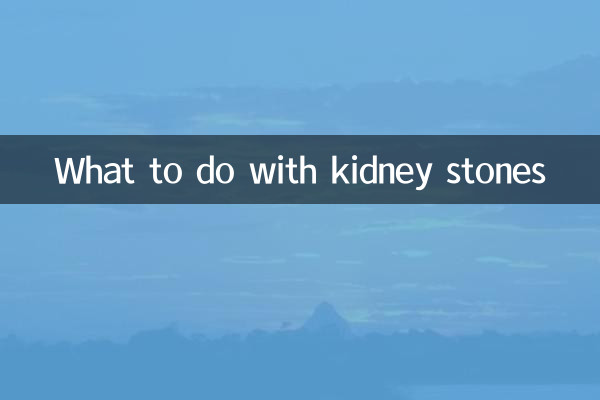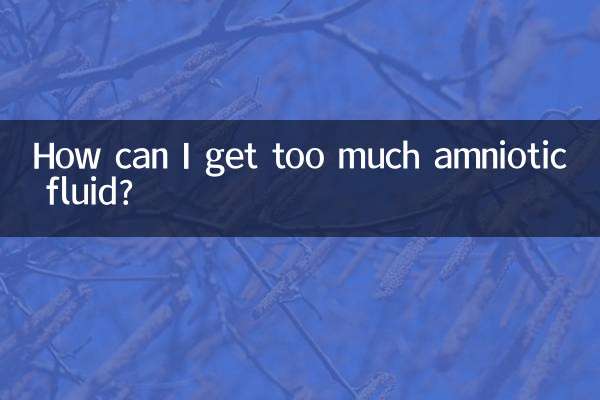What to do with kidney stones
Renal stones are one of the common diseases of the urinary system. In recent years, with the changes in lifestyle, the incidence has gradually increased. This article will combine popular topics and hot contents on the entire network for the past 10 days to introduce you in detail to the response methods for renal stones and provide structured data for reference.
1. Basic knowledge of kidney stones

Kidney stones are solid substances formed by mineral crystals in the urine deposited in the kidneys. When the stone is small (usually less than 5 mm), it is called a renal stone. Such stones may be excreted naturally through the urine, but may also cause severe pain and other complications.
| Stone type | Percentage | Features |
|---|---|---|
| Calcium oxalate stones | 70-80% | Most commonly associated with high oxalic acid diet |
| Uric acid stones | 5-10% | Related to hyperuricemia, X-ray does not develop |
| Calcium phosphate stones | 10-15% | Related to urinary tract infection |
| Other types | 5% | Including cystine stones, etc. |
2. Symptoms of kidney stones
Renal stones may be asymptomatic and may also cause the following typical symptoms:
| symptom | Incidence rate | illustrate |
|---|---|---|
| Severe pain in the waist or abdomen | 85% | Sudden attack, colic |
| hematuria | 75% | Blood and urine under the naked eye or microscope |
| Urinate frequently | 60% | Especially when the stone is located at the lower end of the ureter |
| Nausea and vomiting | 50% | Severe pain caused |
| Asymptomatic | 15% | Only found during physical examination |
3. Family treatment methods for kidney stones
For renal stones with a diameter of less than 5 mm, the following home treatment measures are usually taken:
1.Drink more water: The daily water consumption should be 2-3 liters, and the urine output should be more than 2 liters, which will help the discharge of small stones.
2.Exercise appropriately: Jumping, rope jumping and other movements can promote the movement and discharge of stones.
3.Pain relief treatment: Nonsteroidal anti-inflammatory drugs can be used to relieve pain, such as ibuprofen, etc.
4.Dietary adjustment: Adjust dietary structure according to the composition of stones.
| Stone type | Recommended diet | Restricted diet |
|---|---|---|
| Calcium oxalate stones | High calcium diet, low salt | High oxalic acid foods (spinach, nuts, etc.) |
| Uric acid stones | Alkaline food | High purine food (seafood, animal viscera) |
| Calcium phosphate stones | Acid foods | High calcium food |
4. When do you need medical treatment?
If the following situations occur, seek medical treatment in a timely manner:
1. Severe pain cannot be relieved
2. Signs of infection such as fever and chills
3. Continuous vomiting and unable to eat
4. The urine volume is significantly reduced
5. Stones exceed 5mm
6. Conservative treatment has not been discharged for 2 weeks
5. Medical treatment methods
Depending on the size and location of the stone, your doctor may recommend the following treatments:
| Treatment method | Applicable | advantage | shortcoming |
|---|---|---|---|
| Drug stone removal | <5mm stone | Non-invasive, economical | Long course of treatment |
| External shock wave gravel | 5-20mm stones | Non-invasive | There may be residuals |
| Ureteroscopic lithotomy | Middle and lower ureteral stones | Accurate | Need anesthesia |
| Percutaneous nephroscopic lithotomy | >20mm stones | Large stones are effective | Great trauma |
6. Measures to prevent recurrence of kidney stones
1.Keep drinking enough: Maintain the urine volume at 2-2.5 liters in 24 hours.
2.Dietary control: Adjust diet according to the composition of stones and limit sodium intake.
3.Regular physical examinations: Do an urinary ultrasound examination once a year.
4.Moderate exercise: Avoid sitting for a long time and promote metabolism.
5.Control weight: Obesity is one of the risk factors for kidney stones.
Conclusion
Although renal stones are common, most patients can obtain a good prognosis through reasonable home care, timely medical treatment and scientific prevention. The key is to understand your own stone type and take targeted prevention and control measures. If the symptoms continue or worsen, be sure to seek medical treatment in time to avoid delaying treatment.

check the details

check the details